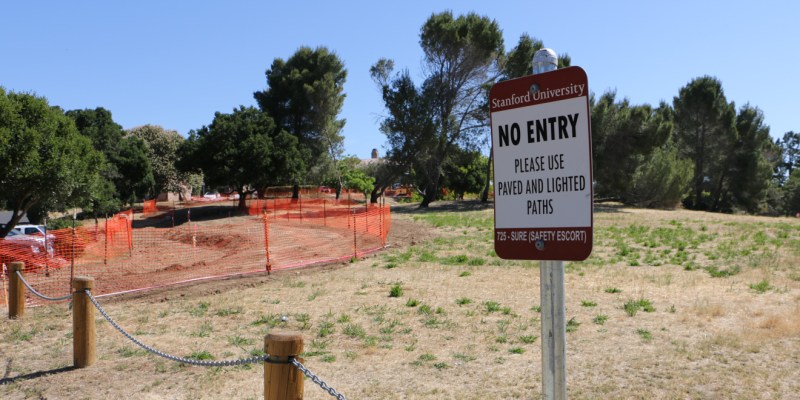
Construction began last week to replace so-called “Scary Path,” the dirt trail connecting residences near Lake Lagunita, with a paved, lighted walkway called the Knoll Path. Scary Path, which is near the site of former Stanford student Brock Turner’s sexual assault conviction, drew widespread criticism from students in recent years for being unsafe.
For Alexis Kallen ’18, who spearheaded the efforts to address Scary Path, the new Knoll Path is a victory for student activists and an important step in preventing sexual assault. Kallen believes the path, which will be lit and include a “blue light” emergency call box, will increase safety and police supervision in that part of campus.
According to Kallen, concerns about Scary Path surfaced in 2014 when the ASSU, after receiving hundreds of emails about the area from students, brought the issue to the vice provost. In 2015, the administration established the Knoll Path working group comprising of students and administrators tasked with finding a solution to complaints about Scary Path. After two years of discussion, the group developed its proposal for an alternate route that would connect nearby existing paths.
Unlike Scary Path, the Knoll Path will be an official path instead of an informal shortcut. The path will span from the Knoll building to Breer Library, where it will connect to Lomita Drive. Construction is expected to be completed by the end of the summer.
Scary Path is now closed and will be reseeded and restored as a wildlife habitat.
Kallen said she first became interested in the issue as a freshman when she felt unsafe while walking home from a party on the path. After bringing her concerns to the ASSU president at the time, she became a member of the Knoll Path working group.
However, Kallen said she and others on the working group encountered difficulties in trying to improve Scary Path. Building an official path required county permits and had to comply with the Habitat Conservation Plan under federal law to protect the tiger salamanders local to the area (Kallen said the species will not be disturbed by the new path’s construction). The project also had to comply with the Americans with Disabilities Act.
Some of the students in the working group said that the administration could have been more receptive toward student concerns.
“We had already gathered a lot of input and a lot of data and quotes from students saying that it was an issue, and when it was brought forward it wasn’t really seen as valid proof that students felt that Scary Path was a concern,” said Matthew Baiza ’18, a member of the working group.
However, the University maintains that the administration was fully supportive of the initiative.
“The university immediately began working with students who were worried about the Knoll Path,” wrote spokesperson E.J. Miranda in an email to The Daily. “They were involved and engaged in the Knoll Path group with university staff, which led to the solution to relocate and light the pathway to address student concerns about the area.”
Despite initial difficulties, the administration and student representatives came to a consensus. According to Baiza, the working group ultimately decided that building the Knoll Path benefited everyone involved and would make the University a better place.
While many students associate Scary Path with partygoers, members of the working group emphasized that the path poses a danger not only to students returning from parties but also to those who live in the surrounding residences and traverse the path on a daily basis.
“I definitely think that it’s scary and that it gets very dark at night, and you’re kind of by the lake and there are sometimes not a lot of people around or other university buildings,” said Riya Mehta ’18, a resident of Narnia House who sees the new path as an improvement. “It would be different if it weren’t a daily occurrence, but this is where I live. I have to come home every night like this.”
After two years of working towards a solution to Scary Path, Kallen urged students to keep fighting to combat issues like campus sexual assault that the path project sought to address.
“A lot of time all we hear is the administration turning down efforts to fight against sexual assault,” said Kallen. “If students continue to fight for this and be respectful and work and just keep going, then we can actually get these projects passed and make campus safer one step at a time.”
However, Miranda disputed Kallen’s assertion that the administration has been refusing to develop initiatives to fight sexual assault, and emphasized that the University actively seeks out student voices to be involved in its efforts.
“The university wants to work with Stanford students to develop new and better ways to combat sexual assault,” Miranda wrote. “We are not aware of any efforts that have been ‘turned down.’ In fact, many of our programs and initiatives have been developed in partnership with students, and Stanford continues to encourage student involvement.”
Contact Sophie Regan at sregan20 ‘at’ stanford.edu.
